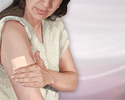How to stop smoking: Dealing with a slip up
As you learn how to live without cigarettes, you may slip up after you quit smoking. A slip is different than a total relapse. A slip occurs when you smoke one or more cigarettes, but then go back to not smoking. By acting right away, you can get back on track after a slip.
These tips can help you stop a slip from becoming a relapse to full-time smoking.
Stop smoking again right away. If you bought a pack of cigarettes, destroy the rest of the pack. If you bummed a cigarette from a friend, ask that friend not to give you any more cigarettes.
Do not beat yourself up. Many people quit smoking several times before they quit for good. If you get too stressed after a slip, it could make you want to smoke even more.
Get back to basics. Remind yourself why you want to quit. Post the top 3 reasons by your computer, in your car, on the refrigerator, or someplace else you will see it throughout the day.
Learn from it. Look at what made you slip, then take steps to avoid that situation in the future. Triggers for a slip can include:
- Old habits like smoking in the car or after a meal
- Being around people who smoke
- Drinking alcohol
- Smoking first thing in the morning
Adopt new habits. Once you figure out what made you slip, plan new ways of resisting the urge to smoke. For instance:
- Give your car a complete cleaning and make it a smoke-free zone.
- Brush your teeth right after every meal.
- If your friends light up, excuse yourself so you do not have to watch them smoke.
- Limit how much you drink. You might need to avoid alcohol for a while after you quit.
- Set a new morning or evening routine that does not include cigarettes.
Build coping skills. You might have slipped in response to a stressful day or strong emotions. Develop new ways to deal with stress so you can get through tough times without cigarettes.
- Learn how to deal with cravings
- Read up on stress management and practice the techniques
- Join a support group or program to help you quit
- Talk to a friend or family member you trust
Continue nicotine replacement therapy. You may have heard that you cannot smoke and use nicotine replacement therapy (NRT) at the same time. While this is true, a temporary slip does not mean you have to stop NRT. If you are using nicotine gum or other form of NRT, keep it up. It might help you resist the next cigarette.
Keep a slip in perspective. If you smoke a cigarette, look at it as a one-time mistake. A slip does not mean you failed. You can still quit for good.
References
American Cancer Society website. How to quit tobacco: help for cravings and tough situations while you are quitting tobacco. www.cancer.org/healthy/stay-away-from-tobacco/guide-quitting-smoking/quitting-smoking-help-for-cravings-and-tough-situations.html. Updated October 10, 2020. Accessed December 1, 2022.
Centers for Disease Control and Prevention website. Tips from former smokers. www.cdc.gov/tobacco/campaign/tips/index.html. Updated September 5, 2022. Accessed December 1, 2022.
George TP. Nicotine and tobacco. In: Goldman L, Schafer AI, eds. Goldman's Cecil Medicine. 26th ed. Philadelphia, PA: Elsevier; 2020:chap 29.
Ussher MH, Faulkner GEJ, Angus K, Hartmann-Boyce J, Taylor AH. Exercise interventions for smoking cessation. Cochrane Database Syst Rev. 2019; (10): CD002295. PMID:3168491 pubmed.ncbi.nlm.nih.gov/31684691/.
Review Date: 8/15/2022
Reviewed By: Linda J. Vorvick, MD, Clinical Professor, Department of Family Medicine, UW Medicine, School of Medicine, University of Washington, Seattle, WA. Also reviewed by David C. Dugdale, MD, Medical Director, Brenda Conaway, Editorial Director, and the A.D.A.M. Editorial team.


